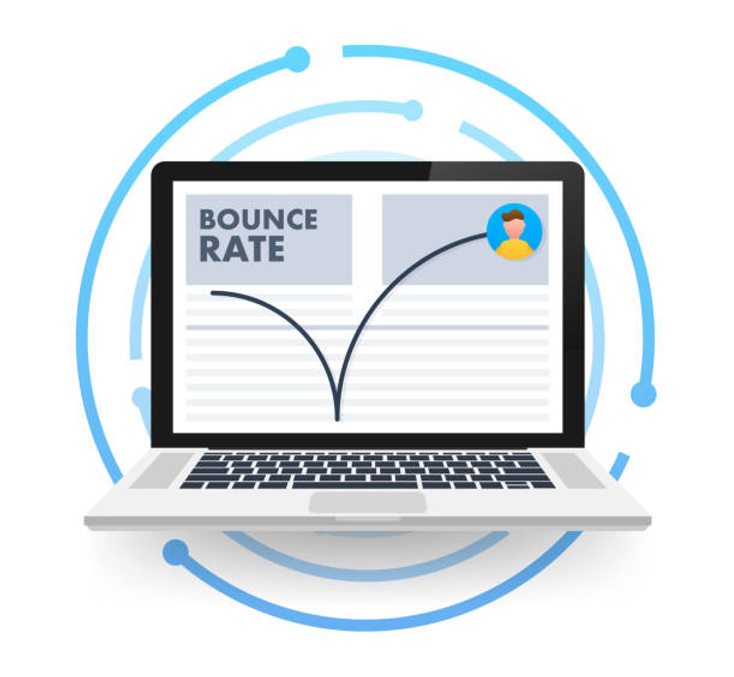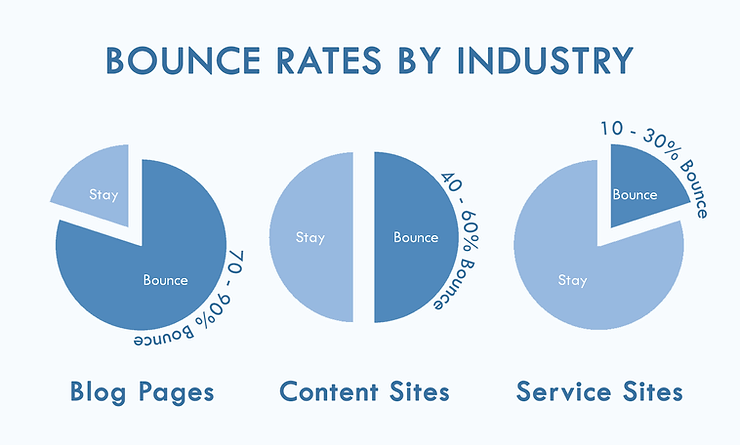What is Bounce Rate?
Bounce rate refers to the percentage of visitors to a website who navigate away from the site after viewing only a single page, without taking any further action or engaging with the site’s content. In other words, it measures the rate at which visitors “bounce” off the website without exploring it further.
The bounce rate is calculated by dividing the number of single-page visits by the total number of entrances to the website and expressing the result as a percentage. It provides insights into the effectiveness of a website in capturing and retaining visitors’ attention.
A high bounce rate generally indicates that visitors are not finding what they are looking for or that they are not engaged enough to continue exploring the site.
However, it’s important to note that bounce rate should be interpreted in the context of the website’s purpose and objectives. For some types of websites, such as blogs or news sites, a higher bounce rate may be acceptable if visitors are consuming the desired content on the landing page.
On the other hand, for e-commerce or lead generation sites, a high bounce rate could indicate issues with user experience, content relevance, or other factors that need to be addressed to improve engagement and conversion rates.

What to Watch Out For With Bounce Rate?
When analysing bounce rate, there are a few key factors to watch out for:
- Context and website type: Bounce rate should be interpreted in the context of your website’s purpose and objectives. Different types of websites have varying expectations for bounce rates. For example, a blog or news site where visitors often come for a specific article may have a higher bounce rate compared to an e-commerce site where visitors are expected to browse and make purchases.
- Landing page relevance: A high bounce rate may indicate that your landing pages are not meeting visitors’ expectations or delivering the information they were seeking. Assess the content and relevance of your landing pages to ensure they align with visitors’ intent and provide a clear value proposition.
- User experience: Poor user experience can contribute to high bounce rates. If your website has slow loading times, confusing navigation, intrusive pop-ups, or other usability issues, visitors are more likely to leave without exploring further. Optimise your website for fast loading, intuitive navigation, and mobile responsiveness to enhance the user experience.
- Content quality: If your content doesn’t engage visitors or fails to deliver what they expect, they may leave immediately. Ensure your content is valuable, informative, and engaging, catering to your target audience’s needs and interests. Use compelling headlines, well-structured articles, and relevant multimedia to capture visitors’ attention and encourage further exploration.
- Call-to-action (CTA) effectiveness: If your website lacks clear and persuasive CTAs, visitors may not be prompted to take the desired actions, leading to higher bounce rates. Make sure your CTAs are prominently displayed, visually appealing, and compelling, guiding visitors to the next steps you want them to take.
- Traffic sources: Analyse the sources of your website traffic to gain insights into bounce rate patterns. Different traffic sources may exhibit varying bounce rates due to the nature of their referral or the quality of the traffic. For example, visitors from organic search results may have different intent compared to those from social media or paid advertisements.
- Technical issues: Occasionally, high bounce rates can be caused by technical issues such as broken links, error messages, or other website malfunctions. Regularly monitor your website’s performance, conduct regular checks for broken links, and address any technical issues promptly.
By considering these factors and analysing bounce rate in conjunction with other metrics, you can gain a better understanding of visitor behaviour, identify areas for improvement, and optimise your website to increase engagement and achieve your goals.
How to improve your bounce rate?
To improve your bounce rate and encourage visitors to explore your website further, consider implementing the following strategies:
Enhance landing page relevance
Ensure that your landing pages align with visitors’ expectations and deliver the information they are seeking. Optimise your meta titles and descriptions to accurately reflect the page content and use targeted keywords. Provide a clear value proposition and compelling headlines to grab visitors’ attention and entice them to stay.
Improve website design and user experience
Create a visually appealing and user-friendly website design. Make sure your website loads quickly and is optimised for mobile devices. Streamline your navigation to make it intuitive and easy to use. Eliminate any distracting elements that may hinder user experience, such as excessive pop-ups or autoplay videos. A smooth and enjoyable user experience encourages visitors to explore further.

Create high-quality content
Produce valuable, relevant, and engaging content that meets the needs of your target audience. Craft compelling headlines to capture attention, and format your content to make it easy to read and digest. Use multimedia elements like images, videos, and infographics to enhance the visual appeal and increase engagement. Well-written and informative content encourages visitors to spend more time on your website.
Optimise page load speed
Slow-loading pages can lead to high bounce rates. Compress images, minify code, and leverage browser caching to improve your website’s loading time. Use tools like Google PageSpeed Insights or GTmetrix to identify specific areas for optimisation and follow their recommendations.
Enhance content organisation and readability
Structure your content with subheadings, bullet points, and paragraphs for easy scanning and readability. Break up long blocks of text and make it visually appealing. Use relevant internal links to guide visitors to related content on your website, encouraging them to explore further.
Target relevant traffic
Focus on attracting the right audience to your website. Ensure that your SEO efforts target relevant keywords and phrases that align with your content and audience’s intent. Engage in targeted advertising campaigns to attract visitors who are genuinely interested in your offerings. By driving relevant traffic, you increase the chances of visitors finding value and engaging with your website.
Monitor and analyse data
Regularly monitor your website analytics to gain insights into visitor behaviour and identify patterns. Analyse bounce rates across different pages, traffic sources, and user segments. This data can help you understand areas for improvement and guide your optimisation efforts.
Remember that reducing bounce rate is not always the sole objective. Some pages, such as blog posts with specific information, may naturally have higher bounce rates. Instead, focus on providing a positive user experience, delivering valuable content, and guiding visitors towards relevant actions.

Why Bounce Rate is Important?
Bounce rate is an important metric in SEO (Search Engine Optimisation) because it provides insights into user behaviour and the effectiveness of a website in engaging visitors. Bounce rate refers to the percentage of users who navigate away from a website after viewing only a single page, without interacting further or exploring other pages on the site.
When a user clicks on a search result and quickly leaves without engaging further, it indicates that the webpage they landed on did not meet their expectations or needs. Bounce rate is important because it provides valuable insights into the effectiveness of your website in engaging and retaining visitors.
Firstly, bounce rate is a reflection of user satisfaction and relevance. High bounce rates can be indicative of various issues, such as irrelevant or misleading search results, poor user experience, slow page load times, unappealing design, or lack of compelling content.
Search engines like Google take user behaviour signals into account when determining the quality and relevance of a website, so a high bounce rate can negatively impact a site’s search engine rankings.
Secondly, bounce rate can provide insights into the effectiveness of landing pages. Landing pages are crucial in SEO as they are often designed to convert visitors into customers or leads. A high bounce rate on a landing page could indicate that the page is not effectively capturing the interest or attention of visitors.
It may suggest that the page lacks a clear call-to-action, has confusing or irrelevant content, or fails to meet the expectations set by the initial search query. By monitoring and analysing bounce rates on landing pages, website owners can identify areas for improvement and optimise their pages to increase conversions.
If you were to give any new self-storage owner, 2-3 tips what would those be? (It could be marketing, security, or operations)
Security, Security, Security 😊
1. Engage with a security supplier early, well ahead of the build phase of any new stores and ahead of any acquisition takeovers.
2. Educate yourselves on the technology and terminologies within security, the SSA will be able to help with myth busters and terminology descriptions. I’m happy to help in my current position as Chair of the Security Sector Forum.
3. Ensure clarity amongst your staff with regards to your assignment instructions and operating procedures for your security systems, suppliers and ultimately, and hopefully, your remote monitoring.











We have been working with Amax Marketing for the last few weeks and have already been impressed with the results we've seen.
As experts in outreach and digital PR, we knew we'd be in safe hands. We are looking forward to the coming months, and getting some fantastic results!